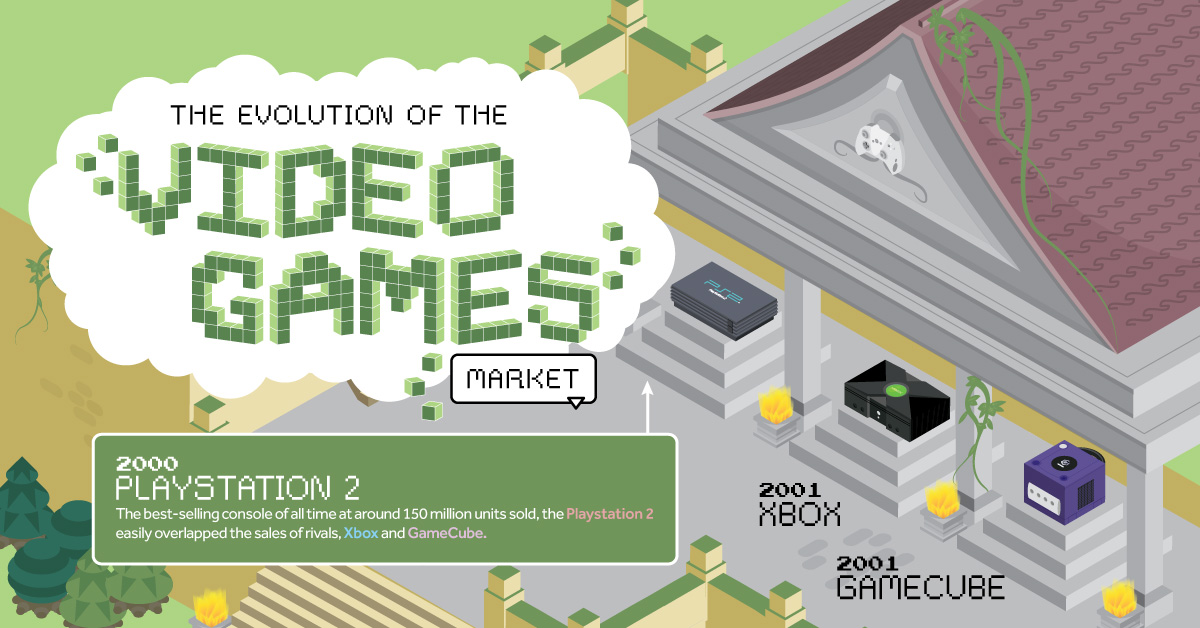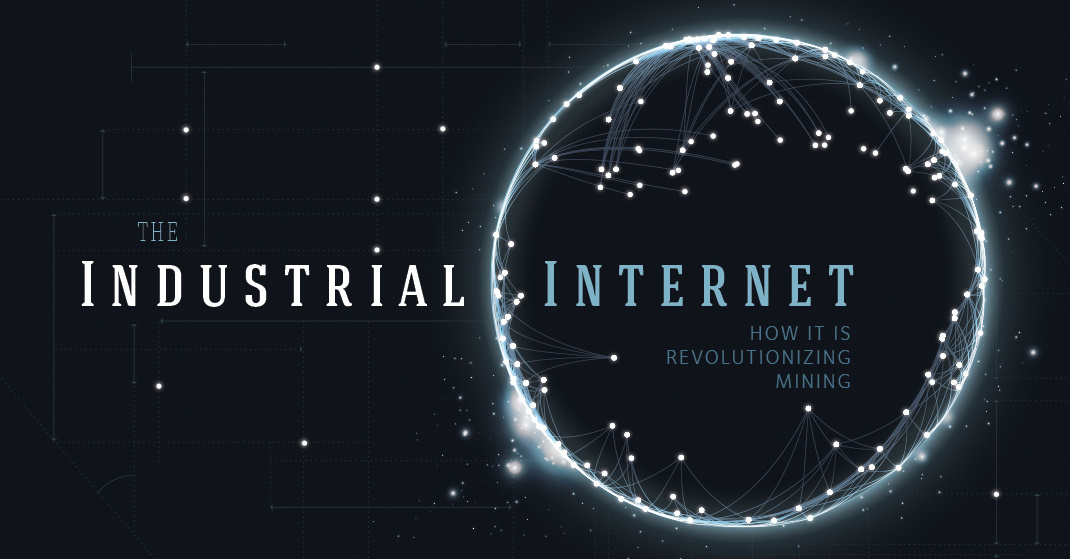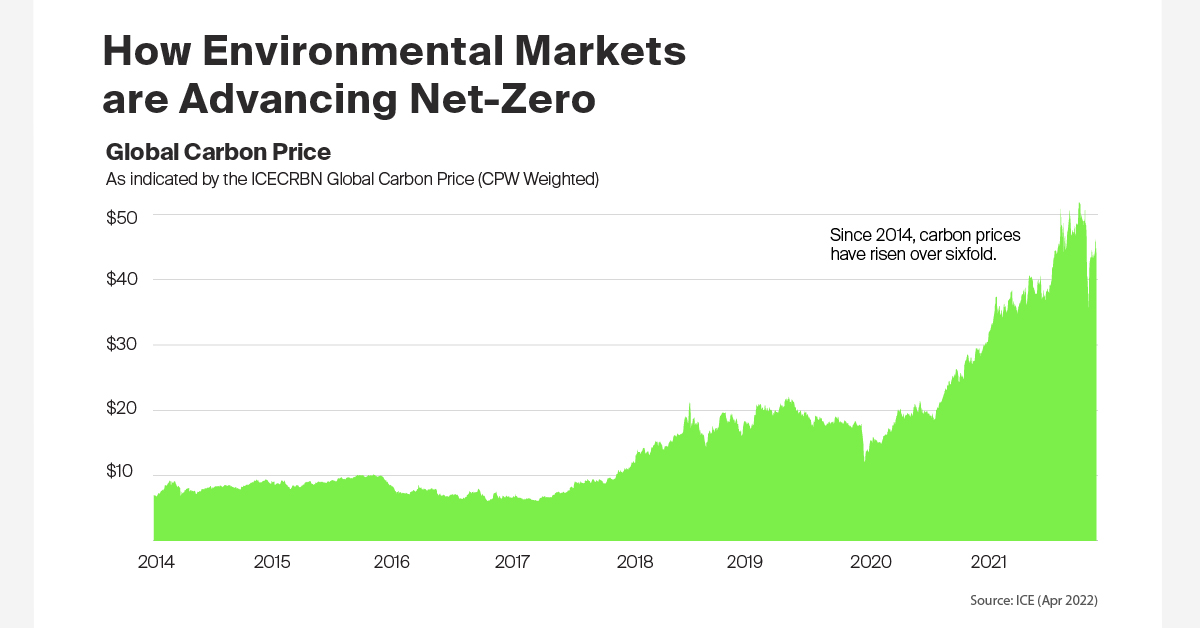How Environmental Markets Advance Net Zero

How Environmental Markets Advance Net Zero
In 2021, roughly 20% of global carbon emissions were covered by carbon pricing mechanisms.
Meanwhile, the global price of carbon increased 91%, bolstered by government, corporate, and investor demand. This puts traditional fuel sources at a disadvantage, instead building the investment case for renewables.
This infographic from ICE, the first in a three part series on the ESG toolkit, explores how environmental markets work and their role in the fight against climate change.
What are Environmental Markets?
First, meeting a goal of net zero carbon emissions involves limiting the use of the world’s finite carbon budget to meet a 1.5°C pathway.
Achieving net zero requires us to:
- Change how we utilize energy and transition to less carbon-intensive fuels
- Put a value on the conservation of nature or “natural capital” and carbon sinks, which accumulate and store carbon
Environmental markets facilitate the pathway to net zero by valuing externalities, such as placing a cost on pollution and placing a price on carbon storage. This helps balance the carbon cycle to manage the carbon budget in the most cost-effective manner.
What Is the Carbon Budget?
To keep temperatures 1.5°C above pre-industrial levels, we have just 420 gigatonnes (Gt) of CO₂ remaining in the global carbon budget. At current rates, this remaining carbon budget is projected to be consumed by 2030 if no reductions are made.
| Carbon Budget | 1.5°C | 1.7°C | 2.0°C |
|---|---|---|---|
| Remaining GtCO₂ | 420 | 770 | 1270 |
| Consumed GtCO₂ | 2475 | 2475 | 2475 |
Each scenario based on a 50% chance of success
Source: IPCC AR6 WG; Friedlingstein et al 2021; Global Carbon Budget 2021
Across three different scenarios, the above table indicates the amount of carbon emissions humanity can emit to prevent the worst effects of climate change.
What are Negative and Positive Externalities?
Second, when companies compensate for CO₂ emissions, they can fall across two categories: negative and positive externalities.
- Negative externalities include pollution. Carbon cap and trade programs, using carbon allowances, put a cost on pollution.
- Positive externalities include renewables, such as wind and solar power that generate carbon-free electricity. The value of renewable energy can be expressed with a renewable energy certificate.
Natural capital is another example of a positive externality, which involves the capturing and storing of carbon. The value of this type of natural capital can be expressed using a carbon credit.
Environmental Markets and the Energy Transition
Next, environmental markets can drive the transition to cleaner energy sources by ascribing a cost to pollution and putting a premium on renewables, to change how we use energy.
As one example, in 2013 the UK government introduced the Carbon Price Support mechanism to complement the emissions cap and trade program and weaken the investment case for coal. Between 2013 and 2020, Britain’s overall CO₂ emissions fell by 31%.
Here’s how coal was phased out of the UK’s energy mix, while renewable energy sources such as wind, solar, and bioenergy played a greater role.
| Date | Coal | Gas | Wind and Solar | Bioenergy |
|---|---|---|---|---|
| Q1 2000 | 31 TWh | 40 TWh | 0 TWh | 1 TWh |
| Q1 2005 | 41 TWh | 36 TWh | 1 TWh | 2 TWh |
| Q1 2010 | 31 TWh | 47 TWh | 2 TWh | 3 TWh |
| Q1 2015 | 28 TWh | 23 TWh | 13 TWh | 6 TWh |
| Q1 2020 | 3 TWh | 27 TWh | 28 TWh | 9 TWh |
Source: Digest of UK Energy Statistics (DUKES); BP; EMBER via Our World in Data (2021)
Today, less than 5% of the UK’s electricity is coal-generated, with remaining plants expected to be decommissioned by 2024.
How Environmental Markets are Advancing Net Zero
Finally, as governments increase their commitments to net zero, carbon prices are rising towards a level that requires industries to decarbonize and meet those goals.
In fact, between 2014 and 2021, the global price of carbon has increased over sixfold.
| Date | Global Carbon Price (Year End) | Annual % Change |
|---|---|---|
| 2021 | $47.78 | 91% |
| 2020 | $24.96 | 37% |
| 2019 | $18.16 | -7% |
| 2018 | $19.56 | 102% |
| 2017 | $9.67 | 29% |
| 2016 | $7.52 | -24% |
| 2015 | $9.88 | 7% |
| 2014 | $9.24 | 32% |
As indicated by the ICECRBN Global Carbon Price (CPW Weighted)
Source: ICE (Apr 2022)
As companies begin to treat their carbon footprints as liabilities, there will be increasing demand for environmental attributes, such as carbon allowances and carbon credits.
Managing Risk and Opportunity
Quoted markets like ICE Futures Exchanges and NYSE allow stakeholders to precisely value positive and negative externalities to:
- Manage emissions cost effectively
- Hedge climate transition risk
- Allocate capital to facilitate the energy transition and build carbon sinks
- Create an asset class for Natural Capital
- Invest in assets to meet climate obligations
Everyone is exposed to climate risk which means it needs to be measured and managed.
That’s why balancing the carbon cycle will be critical to managing the world’s carbon budget. Markets are providing greater access, liquidity and opportunity in supporting net zero ambitions.
In part two of the series sponsored by ICE, we’ll look at four motivations for using ESG data.

-

 Sponsored3 years ago
Sponsored3 years agoMore Than Precious: Silver’s Role in the New Energy Era (Part 3 of 3)
Long known as a precious metal, silver in solar and EV technologies will redefine its role and importance to a greener economy.
-

 Sponsored7 years ago
Sponsored7 years agoThe History and Evolution of the Video Games Market
Everything from Pong to the rise of mobile gaming and AR/VR. Learn about the $100 billion video games market in this giant infographic.
-

 Sponsored8 years ago
Sponsored8 years agoThe Extraordinary Raw Materials in an iPhone 6s
Over 700 million iPhones have now been sold, but the iPhone would not exist if it were not for the raw materials that make the technology…
-

 Sponsored8 years ago
Sponsored8 years agoThe Industrial Internet, and How It’s Revolutionizing Mining
The convergence of the global industrial sector with big data and the internet of things, or the Industrial Internet, will revolutionize how mining works.





